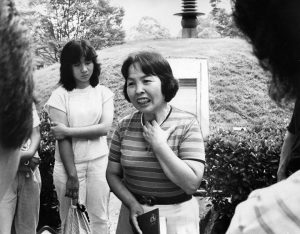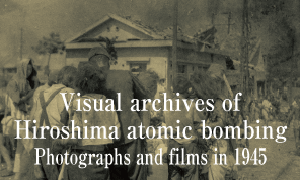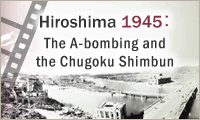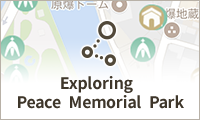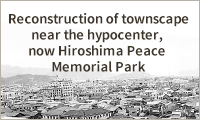Documenting Hiroshima 80 years after A-bombing: In September 1983, series of talks on A-bombing experiences initiated
May 7, 2025
In response to increase in numbers of students on school excursions
by Minami Yamashita, Staff Writer
In September 1983, eight A-bomb survivors began speaking about their experiences in the atomic bombing in a series of talks at the Hiroshima Peace Memorial Museum, located in the city’s Naka Ward. The survivors were commissioned by the Hiroshima Peace Culture Foundation, an organization affiliated with the Hiroshima City government. Prior to that, three museum staff members had shared with the public their own experiences in the bombings. The new system using the A-bomb survivors was introduced to keep pace with the start of full operations of the Sanyo Shinkansen bullet train line and the corresponding increase in numbers of students visiting Hiroshima on school excursions.
Homemaker aged in 50s also participated
The eight speakers included Yoshitaka Kawamoto, director of the Peace Memorial Museum who died in 2002 at the age of 69; Seiko Komatsu, a city official involved in the compilation of the Record of the Hiroshima A-Bomb War Disaster who died in 2008 at the age of 72; and Miyoko Matsubara, a former participant in the World Peace Pilgrimage who died in 2018 at the age of 85. Mitsuko Yoshioka, a homemaker in her 50s at the time, was also among the new members.
According to her personal account and other information, Ms. Yoshioka had experienced the atomic bombing at her workplace in the area of Misasa-honmachi (in Hiroshima’s present-day Nishi Ward) when she was 18 years of age. Her mother, who had been out engaging in building-demolition work, went unaccounted for after the bombing. Her younger brother, a second-year student at the former Sotoku Junior High School, had suffered severe burns in the bombing and passed away around 40 days later. The oldest of her younger brothers died 31 years after the bombing. In 1979, she began speaking about her A-bombing experiences after donating a collection of her own atomic bomb-themed poems to schools throughout Japan.
“A heart that understands human suffering. You don’t have to jump straight into shouting ‘no nuclear weapons.’ First, you need to think about what is happening around you and understand there are people suffering on society’s lower rungs.” That was Ms. Yoshioka’s response to young people who would ask about how nuclear weapons could be abolished. On the day before her sudden death in June 1984, at the age of 57, she had shared her experiences in the atomic bombing with high school students in Osaka. Hearing of the news of her death, the students later sent a message of condolence that included their vow to “never allow war to be waged.”
Visitors to museum soar
In fiscal 1975, the year after the Sanyo Shinkansen line began full operations, the number of visitors to the museum soared, reaching 1,253,145 people, a 42.3% increase compared to the visitor number from the previous year. The number of visitor groups, including students on school excursions, also increased. In fiscal 1984, the year after the program had been launched, the number of talks provided by A-bomb survivors commissioned by the Hiroshima Peace Culture Foundation totaled 370, reaching 62,849 elementary, junior high and senior high-school students, among others. By fiscal 1986, the number of talks had risen to 462 for 80,854 students.
As the number of visitors increased, other groups and individuals began to share their own experiences. In 1987, the Hiroshima Peace Culture Foundation formed a network of A-bomb survivors to communicate their A-bombing testimonies, providing a platform for training and information exchange to enhance such activities. At the first meeting, held in October of that year, a total of around 100 people were in attendance, including individuals and representatives from 13 organizations, including the Hiroshima Institute for Peace Education and the Hiroshima Prefecture Hibakusha Teachers’ Association.
Taeko Teramae, 94, a resident of Hiroshima’s Asaminami Ward, began her involvement as a speaker of her experiences in the atomic bombing for the Hiroshima Peace Culture Foundation in 1984. When Ms. Teramae was 15 years old and a third-year student at Shintoku Girls’ High School, she had been exposed to the flash of light from the bombing 550 meters from the hypocenter while mobilized to work for the war effort. As a result, she lost her left eye.
Her sister, Emiko, 13 at the time, a first-year student at First Hiroshima Prefectural Girls’ High School (Prefectural Girls’ School; present-day Minami High School) who had been mobilized to help with building-demolition work, was killed in the atomic bombing. Ms. Teramae also lost many of her friends in the same class at school. She said, “After suffering injuries in the atomic bombing, I lost interest in living. However, I realized later that was not the right attitude because I had been granted the opportunity to live.”
She was 17 years old when, at the request of a teacher from another school, she first shared her A-bombing experiences with others. “I want people to know about those killed in the atomic bombing, including my friends from the same class, students in younger classes, and the many students that had been mobilized for work,” she said at the time. She continues to talk about her experiences based on that strong determination.
(Originally published on May 7, 2025)

